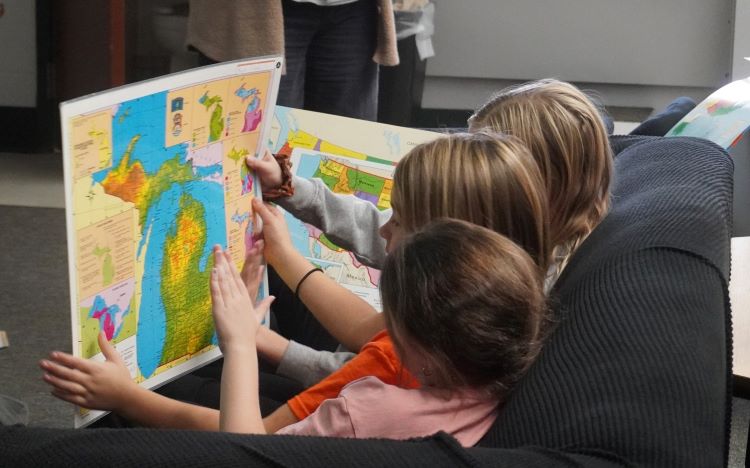Thornapple Kellogg — Third-grader Yeselin Perez-Mendez was amazed at what happened when she threaded two small, circular magnets onto a pencil.
“There’s a magic trick,” she told a visitor, then watched the two magnets bounce off and hover near each other on their own.
Yeselin explained that when the two magnets face one way, they stick together; and when one is flipped, they repel.
Learning about opposing forces was one of several activities Yeselin and her classmates experienced during a recent two-day series of interactive lessons spread over several classrooms.
Each room featured a short video or background information on a social studies or science topic, like magnetism and forces, patterns of motion, map reading and Michigan geography, followed by a hands-on activity.
Third-grade teacher Danielle Nowinsky said the teaching team has done these activities for years, and that students love it. Not only that, “It is fun for the teachers because we get to be creative and fun, and collaborate with each other in a different way than we normally do for math and language arts,” she said.
Nowinsky said offering the lessons in rotations also allows students and teachers to get to know one another and build community.
“Our goal, besides getting the necessary standards taught, is that kids see science and social studies as fun and interesting,” she said. “We have found that students really remember these days and hold onto the information they learn, and it is really fun to watch them get excited about the topics.”
Becoming Topographers and Trapeze Artists
In Julie Toole’s classroom, third-graders learned how to locate their school on a map of Michigan, and the differences between states and countries.

“We live in Barry County,” Toole said. “If you drive a few miles north and move your finger up on your maps, you arrive in what county?”
“Kent County!” replied several students in unison.
Another student located Lake Michigan and Gun Lake on their map, both places they said they have visited.
Nowinsky showed groups a video about trapeze artists — in relation to their invisible forces unit — and how they utilize patterns of motion to achieve their swinging stunts.
Third-grader London observed, “If they swing forward, then they have to swing backward,” like a pendulum.
During the hands-on experiment, third-graders added mass in the form of binder clips to strings that hung from pencils taped to desks.
“We’re not going to be real trapeze artists, but we’re going to use binder clips on a string to try and get it to swing higher,” Nowinsky said.
A crowd favorite classroom station was Brian Hanna’s “hopper popper” lesson in balanced forces and engineering.
“Three, two, one… now!” third-grader Norah Racey counted before she pulled away a ruler she used to hold down a cardboard “popper.”
It sprung up high above their desks, leaving some impressed and third-grader Eli McCarren surprised.
“It works kind of like a mouse trap,” Hanna said. “Rubber bands add force to the cardboard, and that makes it hop when you remove the ruler.”
Read more from Thornapple Kellogg:
• A judge, a meteorologist and a firefighter walk into a school
• They sure do clean up nice










